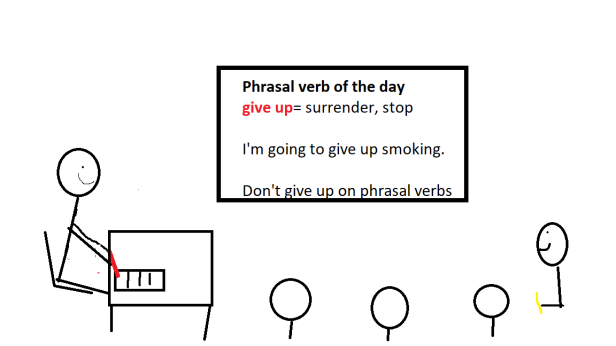I love phrasal verbs. I love teaching them. My students, on the other hand, are usually not so keen on learning them. There are some obvious issues related to phrasal verbs but I used to wonder why they were met with such a degree of animosity. I think one reason is that at B2 level and beyond coursebooks tend to introduce a number of phrasal verbs together and as a result students seem to be overwhelmed by them. For example, a learner may be presented with ‘give up’, ‘give off’, ‘give in’ etc. in the same lesson. I’ve noticed over the last few years that students, perhaps unsurprisingly, often mix up the meanings and prepositions.
Introduce
I’m of the opinion that phrasal verbs should be introduced little and often. Sandy Millin’s post about teaching FCE suggests the very useful FCE Wordbank on Flojoe. Another resource you could refer to is Roy Norris’ list of the 30 most common phrasal verbs at B2 level on Quizlet.
I’ve seen some improvement in students’ knowledge of phrasal verbs since I started to display one or two phrasal verbs during each lesson as a regular part of our lesson plan. I usually put them on the board and I include a phrasal verb of the day poster in my classroom.

Record
In my experience, most students need guidance on how they record their vocabulary. At B2 level students’ notebooks should include a vocabulary section specifically for phrasal verbs. I work with them on what they need to record. (Sandy Millin’s aforementioned post has a really useful example of a student’s notebook which I display early in the course).
As we know, recording the vocabulary alone is not enough. Students not only need a system to write down phrasal verbs but also to review them and put them into practice.
Initial practice
How I practise with students is very straight-forward. I usually ask students to write a sentence using the phrasal verb to check they have understood the meaning and the mechanics of the phrasal verb within a sentence. Students often seem to grasp the meaning of the phrasal verb initially. However, its register, knowing whether it is separable or inseparable, and the contexts in which it can be used, are more difficult.
Review
After eight or more phrasal verbs have been introduced, then review activities are in order. Here are some ideas regarding how to review the vocabulary.
- What’s my phrasal verb? Students look at their notebooks and choose a phrasal verb and write a sentence with it. Once they finish the teacher checks for errors. When all the students have finished they move around the room reading their sentences to each other but beeping out the phrasal verb. Their partner must guess what the phrasal verb is. It doesn’t really matter if students choose the same verbs but to avoid this you could distribute the phrasal verbs to be used. Alternatively, they could give a definition such as ‘reach a decision’ for ‘make your mind up about something’.
- Guess the phrasal verb. In this activity, the teacher reads out a sentence using a synonym where the target phrasal verb could be used. The students must write the phrasal verb that could be used to replace the synonym on a piece of paper, or on the (mini)board if you prefer a competitive edge.
Example.
Teacher reads: I’m going to stop smoking
Students write: ‘give up’ on the (mini) board or piece of paper.
- Clock sentences. This requires a little preparation but has worked well for me in practice. The teacher writes sentences with the recent phrasal verbs missing. The numbered gapped sentences are placed around the classroom on the walls. Students work in pairs and are given a set amount of time with each sentence (i.e. 30-45 secs) before moving to the next sentence in a clockwise direction. They write down the missing phrasal verb in its correct form in their notebooks. After you finish, the sentences should be displayed on the board as the answers elicited/given. For weaker groups, you can display the missing verbs on the board or allow them to use their notebooks during the activity. Keep the sentences you had on the wall for use in future reviews. Here’s an example document which you would cut up and put on the wall (Phrasal verbs with off).
- During writing tasks, when appropriate, encourage students to brainstorm phrasal verbs they might include (i.e. an informal letter about sport could include ‘take up’ ‘give up’ etc).
Another good resource from Roy Norris (again!) is a comprehensive phrasal verb revision list and a number of activities including the FCE sentence transformation style questions here. Lesson Plans Digger has a lot of great suggestions for how to make phrasal verbs fun here.
Ideally, learners should take the initiative to work on phrasal verbs little and often outside the classroom and there are so many apps they can use. As teachers, it’s our role to break it down and show them how to approach phrasal verbs so they are not so overwhelmed, and hopefully, they will be more inclined to do so.
I’d love to hear how other people deal with the phrasal verbs.

Great article! Phrasal verbs are definitely an issue for us English learners! A good advice I heard for teaching the “Verbos con preposición” in Spanish was to introduce the preposition that normally goes along with the verb at the moment of learning the verb, instead of waiting for the students to reach a certain level to present all of them at the same time. Basically, the same approach you propose here for presenting the phrasal verbs little and often.
LikeLiked by 1 person
Thanks for your comment Alejandro.
LikeLiked by 1 person